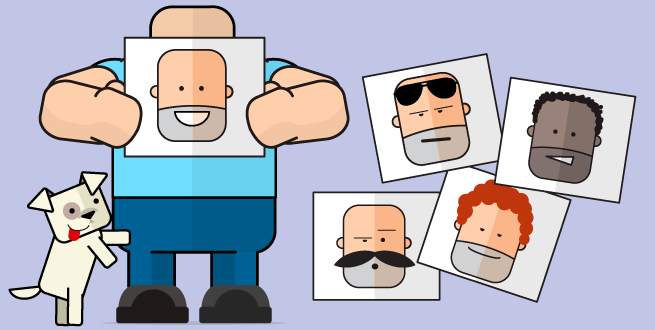Using personas to hit your target audience
Published in 20 de enero de 2016
Any product or service is developed for a particular piece of audience, right? Regardless of the profile, you must know them very well in order to grab their attention. But do you already know it, right? The real question is: how can you do this?
One of the most effective ways to reach your target audience comes from a study of personas. We've already talked about this here, but in this article we will take it a little deeper and show you how the methodology works, as long as it follows as a guide an strategic planning tool to develop and outline business models.
Understanding the concept of personas
The first step before applying any technique is to understand the meaning of what you will do. According to Wikipedia, personas are presented as fictional characters created to represent the different types of users within a target demographic, attitude and/or behavior set that could use a site, a mark or any other similar product.
This is a study, a research, a methodology to create the profile of your target audience in order to ensure that your marketing strategy is hitting the mark ofwho has interest in your company. This represents more opportunities for cross-selling, a deeper understanding of consumers and a greater ability to direct a personalized communication to your customers.
In a few words, it’s a way to customize your email marketing campaigns by segmentation. Creating personas is connected to all data collected from consumers that are divided into groups according to similar preferences. For example, if you work with fashion ecommerce, you can create personas for jeans lovers, for the most connected in the latest fashion trends or for those who like to combine accessories in a more casual style.
This way, you can send more targeted email for each type of customer. To help you in this mission, we point three initial steps, which will be the basis for any communication and marketing strategy through personas segmentation.
1. Make an interview or a survey with your customers
Interviews or surveys can yield valuable feedback from customers of your company. When you prepare specific questions for a single person, the information collected is deeper and more detailed. One way to apply this analysis is by the partnership between emailmanager and SurveyMonkey.
The questions to be applied vary according to the market you work for. We detached a few topics that can be explored to help you create personas:
- How did the customer find your business? (Reference, word-of-mouth, internet, advertising, social networks)
- Why did he or she choose your company? (Price, customer service, product)
- His or her company/business information. (Size, industry)
- Demographic information. (Age, gender, income ...)
- Location.
- What are the challenges your client faces?
- What problem your product or service can solve for him/her?
These are some examples of questions that can be raised so that you have a position to start creating personas for each product or services of your company. But what comes next?
2. Immerse yourself in the analysis of responses
By bringing together the answers to the above questions, you already have all the necessary materials at hand. From here, begin to refine. With the collected data, divide them into groups according to the profile. The more affinity and similarities remain together while others are separated into other groups.
From this job, you’ll begin to see patterns of behavior through features in common, which will start to shape the profile of your personas.
The work of this second stage, however, doesn’t end here. So keep constant monitoring because consumer preferences may vary over time, and the personas should follow these changes.
3. Gather the features and create your personas
To begin with, you don’t need to be limited to just one persona. We recommend you create 3 to 5. Then, prepare the paper and pen or if you prefer, go to the computer. Draw or search a template for your personas just like the image we used to illustrate this article.
The document, whether on paper or in a Word file, must contain a space for photo and some fields for you to fill with the information collected.
- Who is the customer? (Name, age, region, job, hobbies ...)
- Reasons to use your product or service?
- Reasons to buy your product or service?
- Interests?
- Personality?
- Skills?
- Dreams?
- Motivations? What concerns him or her?
- Frustrations?
- My relationship with ... (here is the area of their business)
This research is part of a strategic planning tool created to develop and outline business models. Known as Business Model Canvas, or Canvas, it’s a pre-formatted visual map with blocks, which may present the above listed ideas to help you to shape the concept of your business.
These spaces can be customized according to your needs, so you will have an overview of the audience type that is compatible with the product or service you want to offer. By choosing this methodology, you have the chance to meet your target audience better and faster.
4. Insert the personas into your marketing planning
Now that you\'ve built your personas, it\'s time to fit them in your marketing strategy. Create a calendar of actions for each portion of your target audience and track the progress of your email marketing campaigns with the personas segmentation.
In addition to the operational work, keep all processes documented for later analysis and a mapping of each step. This will help to define the best actions and will also improve each strategy put into practice.
If you want to know more about personas, we recommend reading a guide prepared by Buffer. These four steps should help you to better understand your target audience and also show how to reach your consumers with the right "solution" to their "problem".
Did you like the content? Share it!